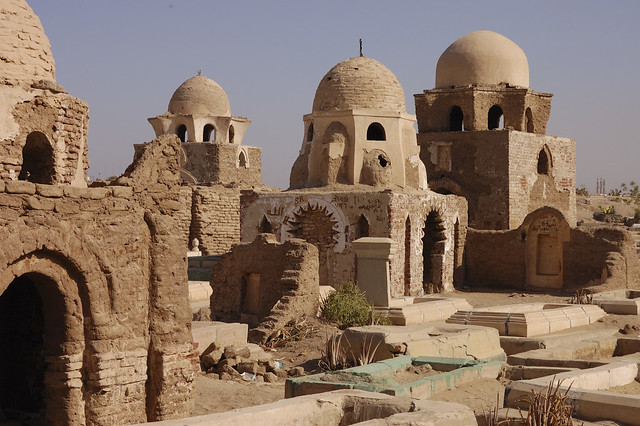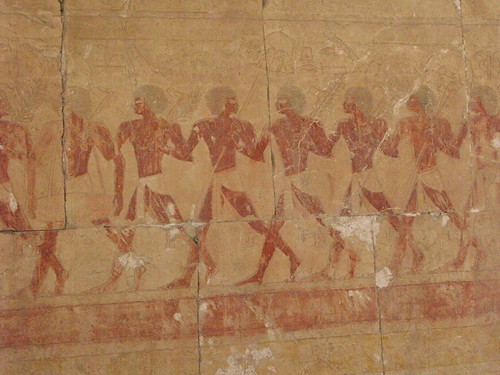We rise early, enjoy breakfast on the boat and meet Dalia for a day around Aswan Philae Island
It's not clear how important Philae was to the earlier Egyptians but the Ptolemies and later Romans made this a very important cult center. The ruins here all date to that later period. This site continued to be used well into the Christian era. It was here that the last known hieroglyphic inscription was carved, about 300 AD.
Although it appears to the visitor that these temples stand as they have for more than two millennia, in fact they have only been where they are now for less than a century. The original name of this Island is not Philae of ancient times but Agilika. In 1903, with the construction of the Aswan low dam, the famous Philae temple complex was partially inundated. as shown in this photo from 1910.

The building of the Aswan High Dam in 1953 threatened to drown Philae and its history. But with the cooperation of the Egyptian government and UNESCO, flooded Philae was pumped dry through the use of a coffer dam. Philae temple itself was carefully dismantled, so that it could be relocated away from danger. Each block of the temple was labelled and its position carefully recorded, so that it could be reconstructed in exactly the same format.
Meanwhile the nearby - but higher - island of Agilika was landscaped and reshaped so that it would look like the site on which the temple was originally standing. All of the blocks were moved and the temple complex was carefully reassembled so that many visitors never realize this is not the original location. The rescue mission took millions of dollars, 10 years to complete and involved the movement of blocks weighing 27,000 tons in total.
The temple complex was later converted to be a Coptic church. In some cases old images were defaced and in others, spells in the Coptic language- grafitti on walls - was used to neutralize the pagan scenes. Two lion statues before the entrance to the hypostyle hall were not defaced. Why? The Coptics decided that St. Mark would be synmbolized by a lion. An Egyptian solution!
In 535 A.D. the temples were closed by order from the Roman emperor Flavius Anicius Justinianus. The priesthood was chased away or put in prison and the art of reading and writing hieroglyphs was forgotten, and not until the 19th century were scholars once again able to read these tales of ancient Egypt.
More pictures from today are here: https://picasaweb.google.com/eloise.hedbor/20110123?authkey=Gv1sRgCKmIiceVz4a__wE#
Next is a quick cab ride to visit the famous Aswan
Across the street from the quarry is a large Fatimid cemetery, about 1,000 years old and still used as a cemetery. It is located over a small hill and has a number of domed and vaulted square buildings that date back to the 10th century AD.

The tombs probably housed the bodies of local governors The Fatimids ruled Egypt Egypt from Tunisia
Across the street is a red granite quarry. This one quarry is the source of every obelisk in Egypt
The quarry had a canal - filled in over the centuries - that probably connected to the Nile and allowed the large stone monuments to float to their permanent locations. All obelisks had to be carved of a single piece of stone. They were laid on boats to float down the Nile and carried by dozens or even hundreds of men to their final location. The picture below comes from the wall of
Hatshepsut's temple that we visited.
Hatshepsut's temple that we visited.

Because the Egyptians had no metal harder than bronze, they had to use a harder stone in order to quarry something like granite To extract granite, dolorite balls were pounded against the rock's surface in order to chip into it. Some of those tools are shown below.
They also used wooden wedges to split pieces of granite from the base rock. Soaking wood causes it to expand and a series of strategically wedges was used to break away desired pieces of stone.
Hatshepsut left behind some great obelisks, but she had the intention of creating the largest one the world had ever seen. The one she had planned would have been more than 140 foot tall, more than 1/3 larger than any others. But the natural fractures in the Aswan granite that allowed the extraction of so many wonderful obelisks defeated the makers of this one. After what experts say was probably a year of work, when the workers began the process of levering the giant obelisk from the quarry, a fracture appeared and the three quarters completed obelisk remains here in the quarry, unfinished to this day.
We return to the boat for a quick lunch, and then walk down the quay for a felluca ride to the botanical garden on Kitchener ’s Island .
We enjoyed walking among nice labled tropical trees and flowering bushes from around the world. It is a lovely cool oasis.
Not a single butterfly to be seen, although the sun was out. Got a great set of pictures of a very striking – and half tame –bird. It is a Hoopoe , Israel ’s national bird, and it appeared on the scepter of Horus in ancient Egypt
How Jim knew the name of this bird is a mystery to both of us! He does not ever recall seeing an image of it, and thinks he may have read a description once.
Last on today's agenda is a boat trip through a natural area to the Nile's first cataract. The entire river passes between narrow rapids among many small islands. This was a big challenge in antiquity – end of the road for easy travel on the Nile . Expeditions further south had to either by pass by land, or pull smaller boats through using ropes from the shore.
It is so narrow in places that we are scraping against the overhanging vegetation on both sides.
We thread our way among the islands, sometimes having to push off from one side and then the other. We see many different sorts of birds, including kingfishers, several kinds of herons, ducks, and several Purple Gallinules with their huge feet (one seen above).
The word Philae means “the end,’ and Aswan Nubia
We return to our boat (second from the left) in the evening for a final nice dinner and a good night’s sleep. We will check out in the morning.
Our cabin boy leaves us one last example of his linen art, two graceful cobras.















No comments:
Post a Comment